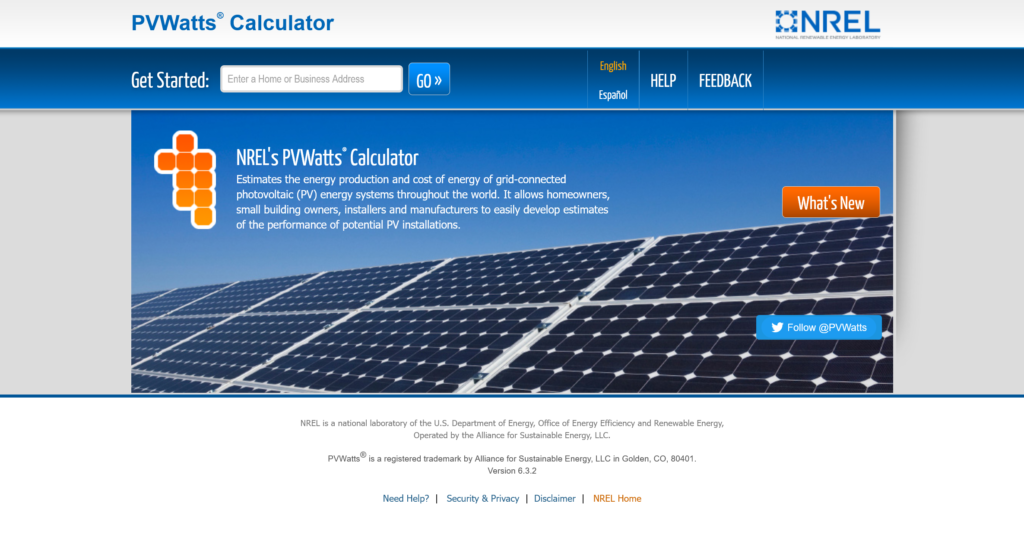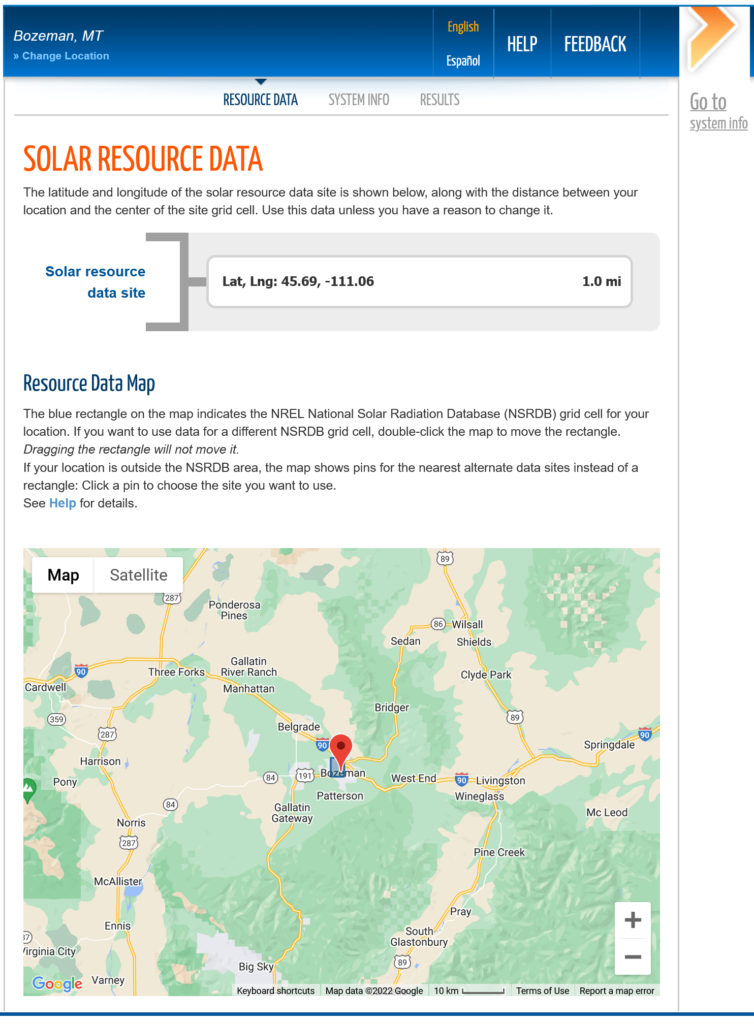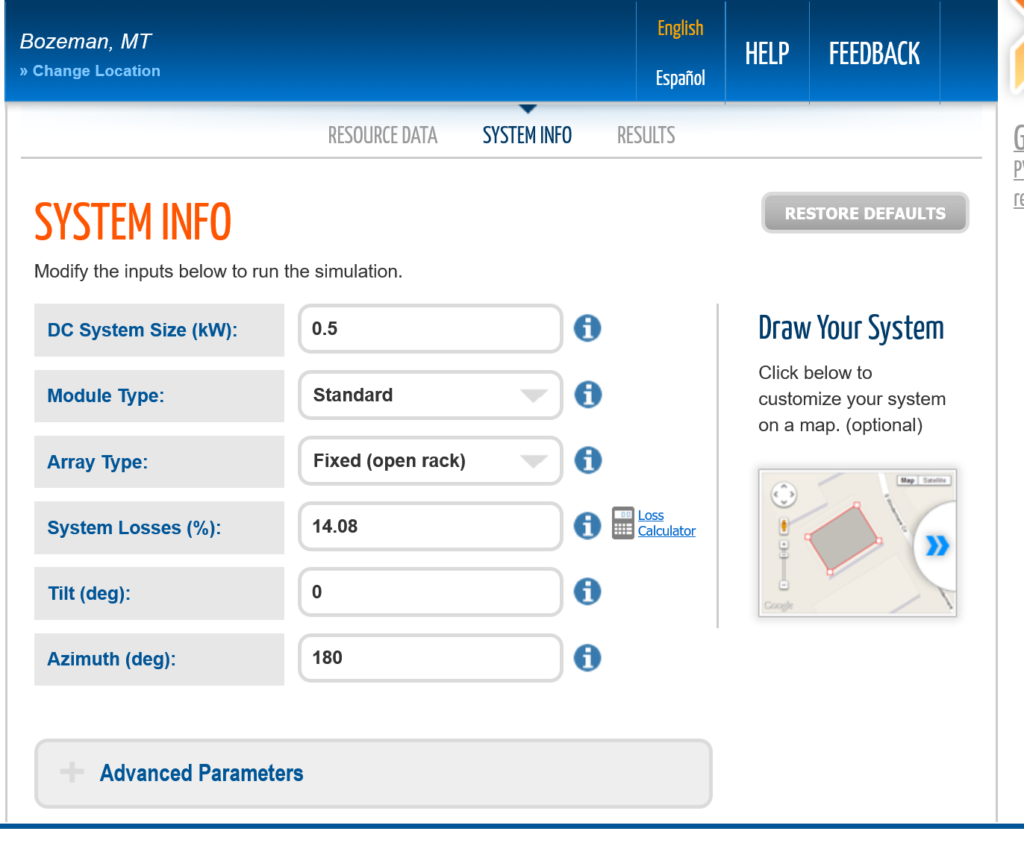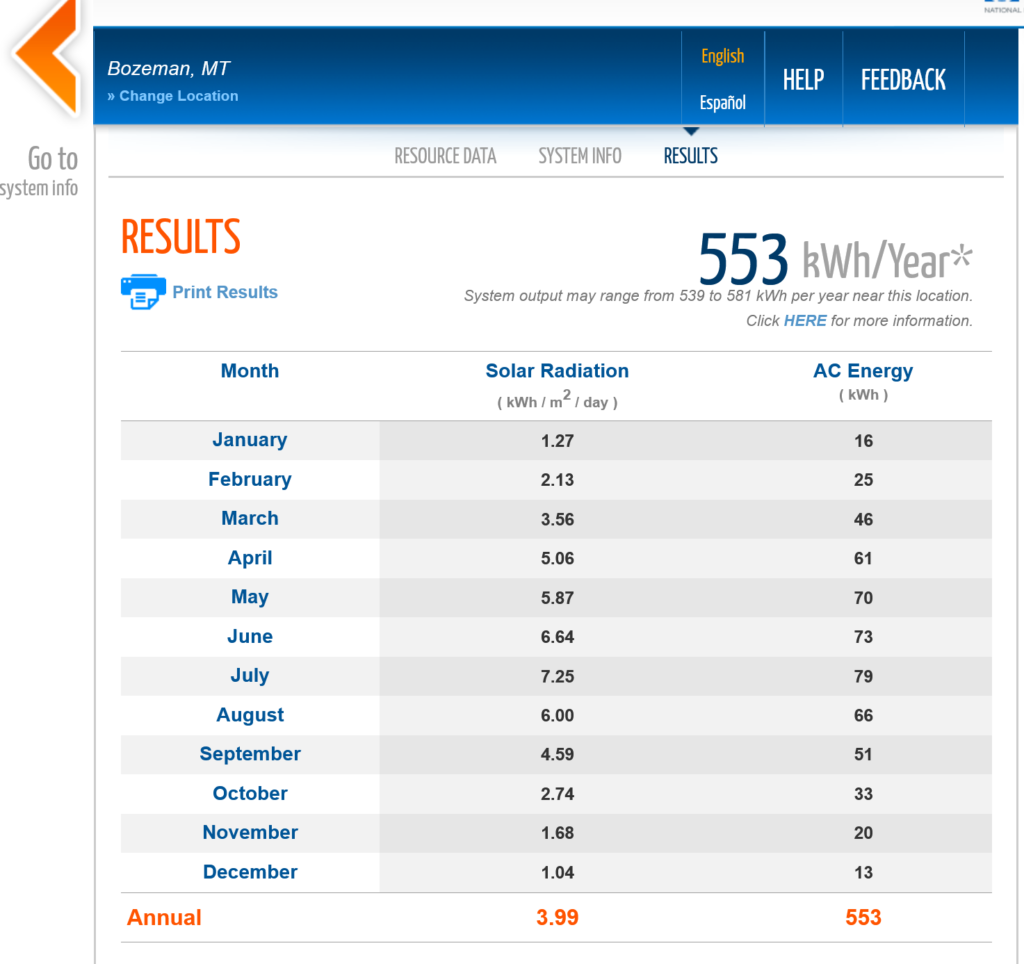This page goes into a number of solar topics:
- Do you want solar?
- Types of solar panel installs
- Solar racks and MPG
- Aero drag guidelines
- How much solar do you need? – PVWatts
Do You Want Solar?
From the other part of this site, you can make a pretty good estimate in daily amp-hours you will use, but how much solar will you need to supply this? And, do you even want to do your charging with solar?
This section aims to help you decide this?
The first question to answer is do you want solar at all? If you drive every day enough to charge the house battery, and/or you spend nights at places that have plug ins, then you may not want to add solar charging. The van alternator charging will likely provide about 40 amps, so, based on your estimated overnight usage, you can make a good guess at how many hour you will need to drive for a charge. For example, 60 amp-hrs of usage for a day and night is pretty common, so driving an hour and half should get you back close to full. If you spend the night at a place with plugins, the with a shore power charger you can have a full battery in the morning. If, on the other hand you like to boondock at a remote place for several days, solar is very helpful.
Types of Solar Panel Installs
A few years ago, it was rare to see solar panels installed on a van, but now there are tons of them and lots of ways to do it. Here are a few…
One large panel mounted for low aerodynamic drag
This is my van – I used a single 315 watt PV panel. To try to reduce aero drag, I mounted the panel as far aft as possible, ran it lengthwise to reduce frontal area, and as close to the roof as possible. The panel is mounted to the roof with four simple right angle aluminum brackets that reduce frontal area compared to a rack. This was back in 2014, and we have been happy with the results – no problems. The aero drag test (down the page) did show fairly minimal aero drag.

A complete description of this installation here…
There is some debate on what effect solar panels have on heat gain through the roof. Some think that the panels shade the roof and therefore help to reduce heat gain through the roof, which makes sense. But, it does not agree with this test I did on my van, which showed higher temperatures under the solar panel. I think that it may depend on the details of the situation, like wind
Glued down flexible panels
Another approach is to use flexible PV panels and attach them to the fan roof with adhesive.
Here is one detailed example of this method…
On the pro side, essentially no aero drag, relatively easy installation, low visibility (stealthy). On the con side, higher price, possibly shorter life, more heat transfer through roof (maybe). But, the saving in gasoline costs for the no aero drag will make up for the added panel price many times over.

I like this method, If I were doing my van again, I would do my panels this way.
Solar Roof Racks and MPG
Last year I got curious as to how much some of these large roof racks for mounting lots of solar panels were costing in aero drag and MPG.
I built this simulated roof rack for my van and did a pretty careful MPG test with and without the rack on my van at 60 MPH. I also did the same test for my more modest single PV panel mounted well back on the van and close to the roof (hopefully for low drag).


This was the result…
The full roof rack was 2.5 MPG worse than the roof with only the Maxfan on it.
Over a 200,000 mile van life, this is 1233 gallons extra gas, or at $3 per gallon $3700 in gas, and 12 tons more of CO2 emissions.
About a 12% decrease of MPG compared to the roof with only the Maxfan on it.
The single aft mounted PV panel was 0.1 MPG worse than the roof with only the fan on it.
Over 200,000 mile van life, this is 45 gallons extra gas, or at $3 per gallon $135 in gas, and about half a ton more of CO2 emissions.
The full test results and details on how the test was conducted is here…
I want to make it clear that I’m very much a fan of solar – my house electricity comes from a DIY solar array, and I run what is probably the largest DIY solar website out there, but the truth is that the solar story on van roofs is not all positive.
Aero Drag Guidelines
Until there is more data roof mounted solar panel aero drag, I’d offer these these tentative design guides:
- keep the PV panels as far aft on the roof as possible
- Avoid putting anything in the high speed airflow where the air coming over the windshield has to make the corner onto the roof – an area where the airflow should not be disturbed
- Mount the solar panels to the roof with clips or adhesive, which have low frontal area
- Avoid racks which add frontal area and tend to elevate the solar panels
- Keep the panels close to the roof
- Using the thin, flexible panels attached with adhesive is likely the best solution of all
These guidelines are based on the aero test I did (below) and on the test done by Larry on the ProMaster forum and on some aero absorbed in 35 years as an engineer at Boeing. Its quite possible some of this is wrong, and if you have solid evidence that there is a better way, lets hear it.
How much solar do You need?
The number of amp hours a solar array will produce depends on many thing
- Where you are located
- What time of year it is
- Are the panels mounted flat on the roof, or tilted toward the sun
- The weather that day (rain does happen)
- Even things like wildfire smoke can make a significant difference.
Luckily, there is a very good tool called PVWatts to help with a lot of this. PVWatts was developed by NREL and takes into account your location on the earth, the time of year, average local weather, and the direction your panels are aimed. As you will see, your location and time of year are very big swingers – using rules of thumb that don’t consider these things is going to give poor results.
Lets work through and example for Bozeman, MT (the center of the universe for some of us).
Click this PVWatts link, and you will get to this page…

Enter a zip code or town and <enter>. The town can be anywhere on the face of the earth. You will get this…

You can drag the location indicator around on the map to adjust if you want to, but a few miles is not likely to make a whole lot of difference.
Click the GoTo button, which will bring you to this page…

This is where you enter the data for your solar array.
DC System size is the size in KiloWatts of your array. So, if you have 500 watts of solar, enter this at 0.5 kilowatts (that is just divide your watts by 1000).
Module of Standard is fine.
Array type of Fixed (open rack) is fine. But, if you plan to use movable panels outside your van that you are willing to aim at the sun a few times a day, you could use 2 axis tracked.
The default system losses are probably good – you can check into the details if you want to adjust them.
Tilt Angle should be 0 deg for a roof mount. If you have the capability to adjust the panel tilt, then start with a tilt equal to your local latitude.
Azimuth(deg) does not matter for flat roof mounted panels, but if you are tilting the panels start with due south (180 deg).
Double check your inputs and hit the GoTo Results to see how your array does.
You should see a page similar to this…

This is a month by month solar summary for your location. This summary is based on 30 year hour by hour average weather. Let me say that again – the summary is a based on an average of 30 year hour by hour weather at this location!
So, the next question is how do I convert this into something I can use to see how many amp-hrs I’m going to get in a day?
The short answer is take the monthly total for a month of interest and multiply by 2.78 – this will give the average number of amp-hrs your solar array will put into the batteries over a day.
So, for September in Bozeman with 500 watts of solar panel, the monthly total is 51 Kilowatt hours, or multiplying by 2.78, you get 142 amp-hours per average day. Some days will be better, some worse. You can compare that to what you estimated for your daily needs. Be sure to keep in mind that this is for an average day – some days will see no sun at all, and some may yield quite a bit more – this is one thing to consider in deciding how many days of battery you want to have.
What the 2.78 is doing all in one step is dividing the monthly total by 30 days per month, multiplying 1000 to convert from KWH to watt hours, and then dividing by the battery voltage of 12 volts.
Of course, this is not perfectly accurate, but compared to the usual rule of thumb approaches it is amazing.
Some things to note about how much solar varies…
Bozeman gets 13 KWH in December and 79 KWH in July – six times as much solar in the summer as in the winter! If you want to do winter (or even fall) camping this is something to keep in mind -solar in the winter can be tough.
If you run PVWatts for a few locations you will see that solar varies a lot with latitude and local weather. Try comparing sunny Denver to cloudy Buffalo for example.
Try running Inuvik, NWT and see what the solar is like there in the winter! Surprisingly, not much different than Bozeman in the summer.
PVWatts is an accurate and easy to use tool that will get you a good estimate – don’t guess.
If you see any errors or misleading information on this page, or any information that should be added, please let me know in the comments.
Gary 7/26/22

Also, regarding stealth, do you have any pictures taken from the perspective of someone walking down a city sidewalk by your van? The reason I ask is stealth is very important to me and I ~think~ because your panel does not take up the full width of the roof, nor does it extend forward too much, a nosey, average height pedestrian may not be able to see your panel at all while going for a walk? If this is the case, combined with no roof fan, I might be convinced to go with less wattage on the roof at the benefit of stealth (and MPG!). There are always compromises with these buildouts. Less wattage could be offset with a tilting panel design as well. Cheers!
Hi,
I added pictures from 10 ft and 20 ft away taken at eye level on the bottom of this page…
https://www.buildagreenrv.com/our-conversion/promaster-diy-camper-van-conversion-electrical-and-solar/our-promaster-van-conversion-solar-panel-mounting/
You may have to refresh the page to see the new pictures.
Gary
Ok, thanks for sharing the information you have, I’ll read up on Baxsie’s experience. I always have thought flexible = trash because of lower efficiency and degradation. People buy into big wattage #s in the advertising but fail to look into the efficiency. But perhaps the technology/efficiency in flexible panels has advanced. I’ll have a look. RE: degradation, though I’ve seemed to have bought into Will’s thoughts:
https://www.mobile-solarpower.com/solar-panels.html
https://www.youtube.com/watch?v=onMZ_dRSFUs
https://www.youtube.com/watch?v=PBUat-Drilw
There are also these CIGS panels which are advertised as still flexible, but tougher, but they are cost-prohibitive at this time.
The research continues!
Hi,
Post no 18 on this thread is an update on Baxsie’s panels…
https://www.promasterforum.com/threads/ten-year-follow-up-on-direct-mount-of-pv-panel-to-pm-roof.105215/?post_id=858284#post-858284
I asked a couple more questions on life and performance that he will probably answer in the next day or two.
Gary
Hi Bryce,
The better quality flexible panels (eg SunPower, Renogy,…) have efficiencies that are basically the same as conventional glass faced rigid panels. Basically both are in the 20% efficiency area. They both degrade over the years, but the consensus seems to be that the flexible ones degrade faster.
The better quality flexible panels have about the same coefficient of degradation with temperature. Typically good flexible panels and rigid glass faced panels lose about 0.3% in power output per 1 C increase in temperature. But, the flexible panels tend to run a bit hotter being bonded right to the roof.
This guy does a test of the same flexible panels roof mounted and glued down vs laying loose on the ground with maybe a little ventilation under the panels. The roof panels on his test day were about 128F while ground panels were abotu 120F. So, about 4.5 C difference, which would result in a loss of about 1.3% of output. Pretty small, but I’m not really sure if these temp differences are typical.
https://www.youtube.com/watch?v=p7N-tNQNtNM
The life of flexible panels is shorter for sure than rigid glass faced panels. I don’t have any direct experience with fleixible panels, and don’t have a good idea what the average life of a good quality flexible panel would be – very likely longer than 5 years, but hard to say how much longer. Since they are on a van that is likely only going to last 15(?) years its not necessary to have the 25 year life that rigid glass panels routinely have.
From quite a few reports, the life of cheap (low quality) flexible panels is bad – I would not buy cheap flexible panels.
You might try searching the ProMaster forum for actual experiences. The user @Baxsie has flexible panels with going on 10 years of service and has posted about his install and experience with them. You could ask him for an update on how they are doing.
Sorry I can’t be more help. I am going to buy a flexible panel to get some actual experience – stay tuned 🙂
Gary
RE: the flexible panels, I have read they do not last very long because they are not residential rated and are sitting so close to that hot roof that they cook themselves. Do you have thoughts on their longevity? Also, disregarding cost, but even if I were able to blanket my roof with flexible solar panels (because there is no aerodynamic hit) and technically more wattage, isn’t their efficiency so poor that I may come out ahead in terms of solar output with a single, residential panel like you did? Many thanks for your thoughts!